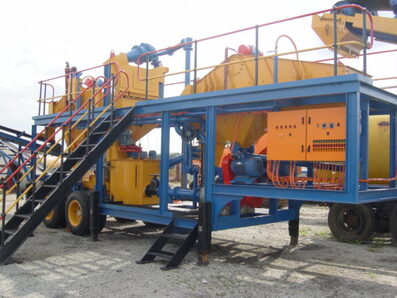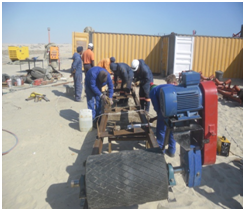The modern DMS plant is a very sophisticated piece of equipment. You need a proper working knowledge to operate your DMS to its proper operating capacity. Let’s look at various aspects of a DMS plant in operation. 
A DMS is a Dens Medium Separator that separates material based on the specific gravity (SG). The density of the medium determines if the material will sink or float depending on the material’s density. Various media can be used, but the common ones are Ferrosilicon (FeSi) and Magnetite.
Testing
The most important thing to remember when you operate your DMS is: TESTING, TESTING AND TESTING. If you measure something you know what the results are. If you are not testing your feed, product and tailings, you will be driving your DMS blindly.
- Test your run of mine
o Ensure the correct grading of your material is as expected. Alternatively you would have to adjust your feed rate accordingly.
- Test your tailings
o Are you losing too much product in your tailings? Adjust your cut point and the same for too little.
- Test your product
o Are you getting too low grade?
Use these readings and plot them on a graph so that you can see when things are running like they should or not.
What is wrong?
When you need to find the fault on your DMS you can use these as a general fault finding guide:
I assume that the product is the sinks from the cyclone for the detail below e.g. Copper, Manganese and Diamonds. If you are processing products like coal you would have your product as the floats in your cyclone and then you would do the reverse of what is described below for the cut points.
Wrong size of material
- Too large material
o The material will clog the pipes further in the process, if the material that you need to mix in the mixing box is too large.
o Investigate your sizing screen for damage to the panels. Somewhere is a hole that lets the larger size of material through.
- Too small material
o If the material is too fine you will see that the fines are contaminating the FeSi.
o Inspect the aperture of the screen panels of the prep screen and ensure that they are not blocked.
o You can also increase the water on the sprayers of the prep screen to remove the amount of fines from your run of mine. It will also help to unblock the smaller apertures and keep them open.
Wrong grade of product
- Grade is too low
o Adjust your SG cut point so that you are getting less product, but at a higher grade.
o Also check that the content of your run of mine is of such grade that you can achieve that required grade.
- Grade is too high
o You can adjust the cut point on your cyclone lower so that more product comes through at a lower cut point.
o If your contract states that you will get paid according to the tonnes at a specific grade then you need to ensure a correct grade for the client by having the correct cut point.
o Selective mining can be performed, but be careful of the risks involved. Be certain where the most cost effective grade is for your operation. Optimise the volume of product at a specific price and cost, so that your profit is the most.
Wrong volume of product
- Too little product
o Check that you are feeding enough tonnes per hour and prevent fluctuations of feed rate. Keep the flow steady.
o Check that unnecessary stoppages are not causing you to lose production
o Check that your run of mine is of a proper and acceptable grade.
- Too much product
o Check your SG cut point that it is not too low.
o Check your feed at the run of mine end that it is not too fast.
o Check that all the aspects are running fine until you set the new optimised level as the new standard level.
Pressure at the cyclone
- Never run without a pressure gauge and ensure that it is accurate.
- Too little pressure
o Check for cracks leaks or holes in the pipes and cyclone.
o Check that the pump running correctly and all the V-Belts have the correct tension.
o Ensure that there are enough feed to the mixing box and the FeSi level is high enough.
o Check the valve settings that the feed is not choked too much.
o Ensure the level of the FeSi is at the overflow, so that the mixing is sufficient. The mixing box should always have enough FeSi so that the overflow ensures the correct level is maintained.
- Too much pressure
o Ensure that the Saunders valve is at the correct setting.
o Check the density of the FeSi medium with a Macy scale to make sure the density controller is functioning correctly.
FeSi
- Cut point on SG
o Make sure the controller is set correctly.
o Do a manual SG test to check the setting of the SG on the controller.
o Ensure the sprayers on the Washing screen are not spraying water into the concentrated FeSi chute, but directs all the washed FeSi into the dilute side of the wet drum magsep.
o As a rule of thumb: “Use rather more water than less”
- Contamination
o Ensure that there are no panels lose or missing on the screens.
o Ensure that the apertures of the panels are not blocked on the screens.
- Is disappearing
o If you have too little water on the sink/float screen then FeSi will stick to the product and be lost. Check to see if you can increase the volume of water sprayed on the panels of the sink/float screen.
o Ensure that the drum is in the correct setting as per the manufacturer’s manual. If the FeSi is not picked up at the drum, it is lost to the slime dam.
o Ensure all the flush points are tightly sealed. No spillages should occur.
Wrong amount of water
- Too little water
o Check your supply for enough water
§ Check if the inlet filters are open and not blocked.
§ Ensure that no water is leaking before it gets to the plant.
§ Endure that the speed of the motor or the condition of the pump is up to standard.
§ Use the pressure gauge to monitor the pressure between 3 Bar and 5 Bar.
o Increase the water to the washing screens in the case where the washing is not cleaning the material effectively.
§ You can also increase the flow rate of the water to the sprayers to ensure better washing of the product or material.
§ Do not adjust the speed of the screen to move the material slower, because it will limit your overall flow rate and can cause various other problems.
o Reuse some of the water captured under the screens for further use in the scrubber.
§ Save on the overall amount of water used by supplementing clean water with grey water from the screens. Use a filter in the recycle pipeline to remove the majority of the solids in suspension, if necessary.
- Too much water
o Spillages will be visible around the lips of the under pans of the screens mainly.
§ Check the pump speed to ensure it is not running too fast.
§ Reduce the supply to what is necessary to be effective by choking the pump or adjusting the VSD on the motor.
o Product or material can be displaced wrongly and lost so that the product and material gets mixed by too much force in the water. Ensure the separator on the sink /float screen is high enough to keep the material from spilling over to the other compartment.
o The SG controller of the DMS will need to add a specific amount of water to control the SG at the set cut point.
Above are a few of the common symptoms and scenarios when you operate a DMS. Although a lot more things can go wrong when you are running at full capacity. That brings us to the next aspect to keep in mind:
Be prepared for downtime
Critical Spares
Keep your critical spares list up to date. Ensure that you have those parts in stock. These parts will enable you to recover from a stoppage so much quicker and more effective. Dynamic Machinery has the facility to keep emergency spares of hard to find items on your behalf as part of your contract.
Regular maintenance
There is no replacement or excuse for not doing preventative maintenance. The small amount of checking and maintenance on the correct time will eliminate costly delays and stoppages of production. Record the maintenance and check which parts of the plant needs maintenance more often.
A small effort on maintenance can save a lot of effort on repairs!
Check the oil and grease of the moving parts. You will see where the wear and tear is a problem, so that you have time to rectify it before something breaks. Use your checklist before you start and after you completed a run to ensure you know your plant inside and out.
Support and training
If any of these points or other points is unclear, please feel free to contact us at Dynamic Machinery. We will help gladly.
At Dynamic Machinery we have seen that our clients on average gets better result from their standard DMS plants, because their operators are better trained and supported. We are supplying a full solution, because we want our clients to produce as much quality product in the shortest possible time.
Dynamic Machinery is prepared to assist DMS owners to get the most out of their existing DMS plant.
Happy processing....

